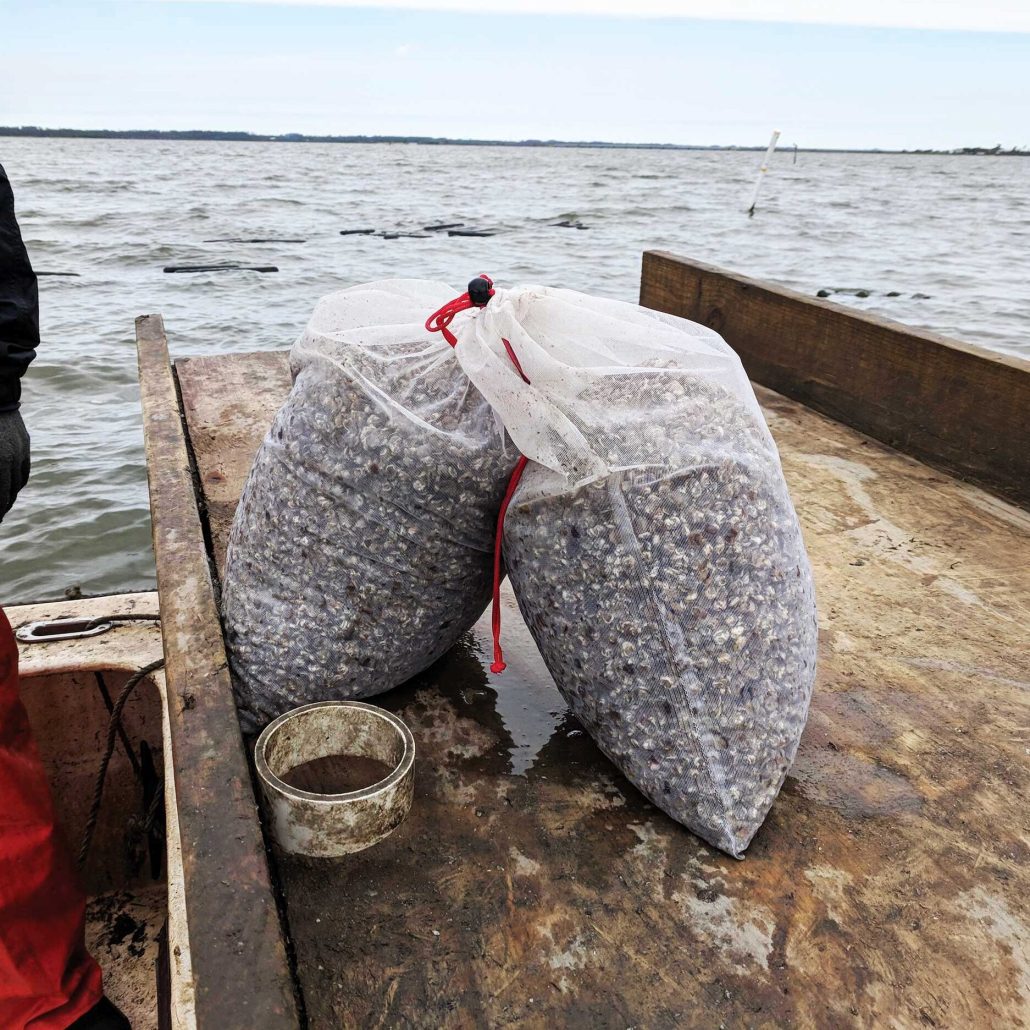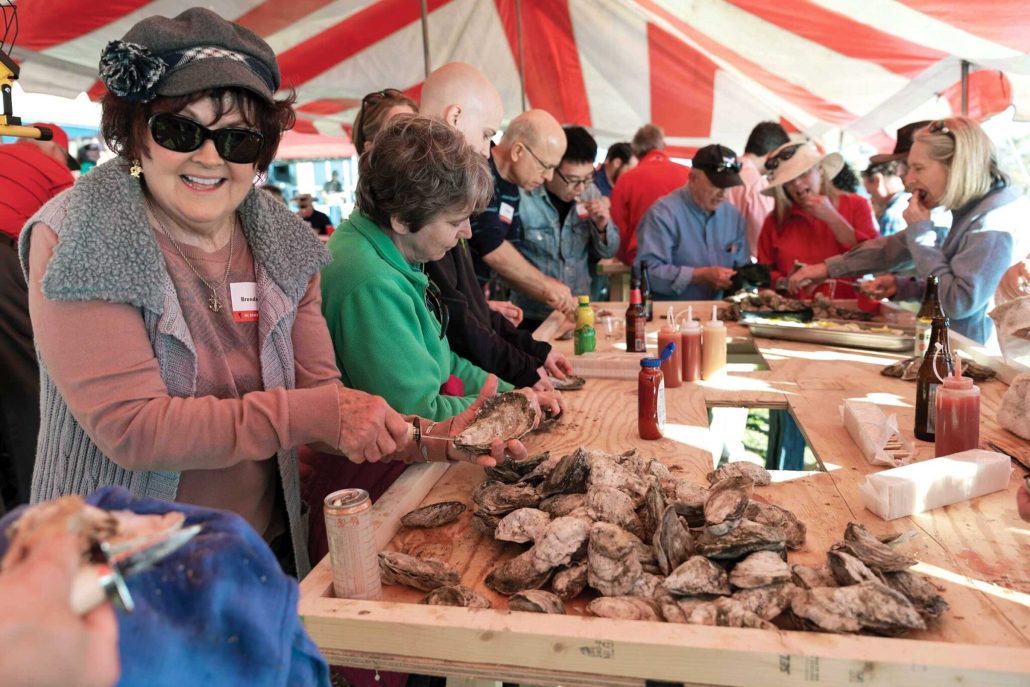Aw, Shucks
A briny bivalve sees a renaissance on the North Carolina Oyster Trail.
by Marti Maguire on January 20, 2022 | Reprinted from NC State Alumni Magazine
ROY EMERSON WAS IN HIS 50S WHEN HE TASTED HIS FIRST RAW oyster, sucked straight from the shell minutes after being plucked from Jarrett Bay, near Williston, N.C. At the time, he was helping harvest the shellfish part time, eyeing a career change that would allow for ample time outside in the salty coastal air. Now, oysters are both his livelihood and obsession; he launched his own farm in 2017. “I was like, ‘Oh, man, this is so great,’” says Emerson, 58, recalling the midmorning snack six years ago. “Now I eat them all the time. I live, eat and breathe oysters.”
Emerson hopes to conjure the same oyster magic among visitors to his Roysters NC farm, one of nearly 40 stops on the North Carolina Oyster Trail. A coastal answer to trendy destination trails featuring bourbon, wine or barbecue, the trail allows visitors to learn about — and, of course, sample — a delicacy that is in the midst of a renaissance in North Carolina.
We want to help visitors and tourists understand the role the oyster plays in our environment and our culture. —Jane Harrison




The trail was created by N.C. Sea Grant, an organization based at NC State that conducts research and outreach to benefit coastal communities, in cooperation with the N.C. Coastal Federation and N.C. Shellfish Growers Association. The trail is open-ended; visitors can consult an interactive map and choose to tour one of 16 shellfish farms, view oyster-focused museum exhibits at one of four educational sites, or choose from among 17 restaurants and six markets from the Outer Banks to the Triangle where they can taste North Carolina oysters. Launched in May 2020, the trail aims to boost interest in oysters and educate the public on an organism that benefits the state’s waterways and economy but is threatened by overharvest, storms and habitat loss. Jane Harrison, a coastal economics specialist with N.C. Sea Grant who helped develop the trail, says it covers “all of the pieces of the oyster puzzle.
“We want to help visitors and tourists understand the role the oyster plays in our environment and our culture,” says Harrison, a faculty member in NC State’s colleges of Natural Resources and Agriculture and Life Sciences. Faculty from the Department of Parks, Recreation and Tourism Management provided research and support to the trail, helping to build a tourism industry centered on shellfish. As more travelers center trips around food, organizers say, mariculture tourism could provide a new revenue stream for oyster growers and an overall boost to coastal economies.

A favored food dating back to Native Americans, the state’s oysters were shipped nationwide starting in the late 1800s, leading to overharvesting that continued through much of the 20th century. Recent efforts by researchers, nonprofit organizations and seafood growers seek to protect and expand oyster habitats, which provide shelter to fish and improve water quality.
While oysters were traditionally dredged from natural beds, they are increasingly grown in cages that float on the surface and can be harvested after 10 to 18 months, compared to an average age of three years for wild oysters. In 2019, the state harvest totaled more than 800,000 pounds and was valued at $4.9 million, according to the N.C. Division of Marine Fisheries. That year, farmed oysters outstripped wild harvests for the first time, Harrison and other researchers found, contributing about $14 million to the state’s gross domestic product, more than half of the $27 million shellfish industry.
Oyster Mythbusting
- Oysters don’t need to be eaten only in the “R” months of September through April. This guideline was meant to allow wild oysters time to reproduce during the summer months, but does not apply to farmed oysters.
- While some types of farmed seafood are bad for the environment, farmed oysters are not; they are grown from native species and improve water quality just like wild oysters.
Emerson is one of many farmers that recently joined the ranks of the state’s oyster growers. He left his job in the pharmaceutical industry for an early retirement, and now spends several days a week out on his boat, working a nearly 2-acre lease in the North River. He starts with “seed” oysters the size of a pinky nail and tends to them as they grow in floating mesh bags — making sure they have ample water flow, moving them to larger bags, and washing off algae. When they’re about three inches long, he sends his Beaufort Briny oysters to markets and restaurants. He says he loves being his own boss and spending time on the water, often with help from his adult children. But it’s physical work, and risky: heavy rains or a drop in water quality can affect his harvest, bringing huge losses. “Now my biggest problem is dealing with Mother Nature,” he says. “Sometimes it’s beautiful, and sometimes it’s not so pretty.”


Emerson joined the trail and started offering his first hour-long boat tours this summer, which feature several farms as well as wild oyster reefs if the tides allow. He teaches visitors about the farming process and lets them sample his oysters, which he calls “flavor bombs” that are salty, then buttery, with a sweet finish. The fees paid for tours are a source of extra income, but he says he started doing them mainly to showcase oyster farming as a sustainable business model. “Oysters are out here improving the environment,” he says, “providing food, filtering the water. We are contributing more than we are taking away.”
A Fabulous Filter: How an Oyster Cleans the Water
Oysters provide food and an economic boost to the coastal communities where they are harvested and served. Here are a few of the ways they benefit the environment:
Water Quality: Oysters are what are known as “filter feeders.” They live on tiny bits of algae floating in water that they obtain by filtering water through their gills. That process also makes water cleaner by removing excess nutrients from the water. A single oyster can filter up to 50 gallons of water a day.
Reefs: Oysters accumulate in reefs that provide habitats for fish and other sea life that use the reefs to hide from predators or feed on the mussels and barnacles that settle there. Species that benefit from the reefs include flounder, shrimp and blue crabs. Healthy oyster reefs can also minimize harm from storms by providing a barrier to erosion.

Statewide, stops on the trail feature wild and farmed oysters, and highlight the variety of flavors and textures found in oysters from different locales. Thanks to factors like the salinity of the water and minerals found where they are raised, oysters from Pamlico Sound to Stump Sound to reefs off the Outer Banks all have a distinct “merroir,” much as the flavor of a wine shows its terroir, factors like climate and the soil where grapes grow. Some visitors sample and compare oysters on the half shell as they might consider wines or craft beer. Are they meaty? Briny? Are the flavors earthy? Others might try them fried or broiled, or on a seaside deck, without a thought to where they came from.
It’s all part of the trail’s allure. “It’s pretty easy,” Harrison says, “to get people excited about eating stuff.”
Oysters are out here improving the environment, providing food, filtering the water. —Roy Emerson
Chris Vergili, chef at the Tidewater Oyster Bar in Wilmington, N.C., says some of his regular customers come in several times a week to sample and compare varieties of local oysters, the centerpiece of the menu at this stop on the trail. They serve about 2,000 local oysters a week, offering four to five types at a time, mostly delivered directly from nearby farms.
Vergili worked previously in established oyster hubs like the San Francisco Bay area, where connoisseurs of the meaty mollusks abound. But he found there were few places showcasing local oysters on the North Carolina coast when he moved there three years ago, and not enough buzz about the many varieties available. Tidewater helped fill that void when it opened last year, he says, and joining the trail was a natural way to help create a community around local oysters. He sees potential for the ranks of oyster aficionados to grow along with the size of the state’s harvest. “The oyster scene in our area is fairly new,” he says. “But these oysters are just as good if not better.”




